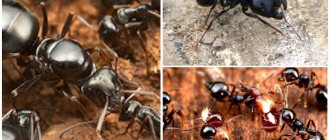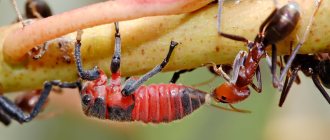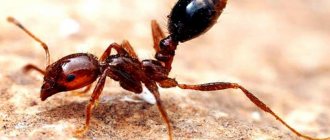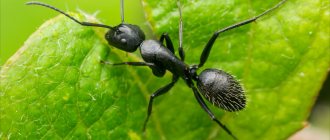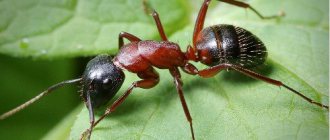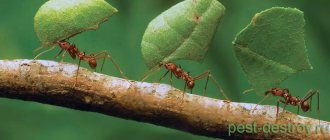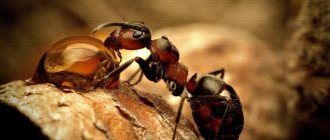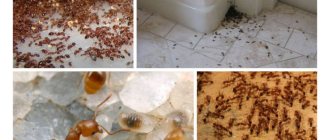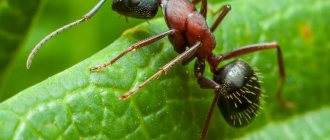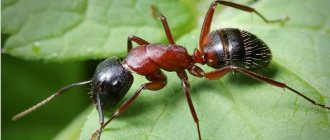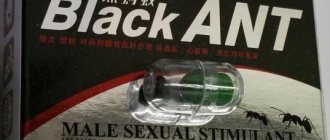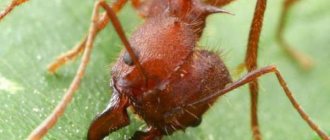Among solitary wasps there are insects that look and behave unusually. The European German is a species characterized by a velvety body cover, the absence of wings in the female and a parasitic lifestyle. Insects do not build their own nests, but attack others in order to lay their eggs there. Aggressive Germans are endowed with a toxic poison that helps them cope with other insects. When attacking a person, the bite site hurts for several hours.
Literature
Key to insects of the European part of the USSR. T. III. Hymenoptera. First part // Suborder Apocrita - Stalk-bellied (Arnoldi K.V. et al.) / under the general. ed. G. S. Medvedeva. - L.: Nauka, 1978. - P. 71–83 (Supersem. Mutillioidea - Lelei A.S.). — 584 p. — (Key guides to the fauna of the USSR, published by the Zoological Institute of the USSR Academy of Sciences; issue 119). — 3500 copies.
- Key to insects of the Russian Far East. T. IV. Reticuloptera, Scorpioptera, Hymenoptera. Part 1 / under general ed. P. A. Lera. - St. Petersburg: Nauka, 1995. - P. 202-211 (Fam. Mutillidae - Germans, or mutillids - Lelei A.S.). — 606 p. — 3150 copies. — ISBN 5-02-025944-6.
- Lelei A. S.
German wasps (Hymenoptera, Mutillidae) of the fauna of the USSR and neighboring countries. - L.: Nauka, 1985. - 268 p. — 1000 copies. - Leley A. S.
Catalog of German wasps (Hymenoptera, Mutillidae) of the Palearctic region. - Vladivostok: Dalnauka, 2002. - 171 p. — ISBN 5–8044–0280–3. - Leley A. S.
Catalog of German wasps (Hymenoptera, Mutillidae) of the oriental region. - Vladivostok: Dalnauka, 2005. - 251 p. - Leley A. S., Kabakov O. N. (1980). To the knowledge of wasps of the families Bradynobaenidae and Mutillidae (Hymenoptera) of Afghanistan
// Entomological Review. - T. 59. Issue. 1. pp. 181-196. - Brothers, D. J. (1975). Phylogeny and classification of the aculeate Hymenoptera, with special reference to Mutillidae.
// University of Kansas Science Bulletin 50: 483–648. - Manley, D. G. and J. P. Pitts. (2002). Key to the genera and subgenera of Mutillidae of America North of Mexico.
Journal of Hymenoptera research. 11: 72-101. - Manley, D. G. and J. P. Pitts. (2007). Revision of the Neotropical velvet ants of the genus Dasymutilla (Hymenoptera: Mutillidae).
Zootaxa, 1487, 1-128. - Nonveiller, G. Catalog of the Mutillidae.
Myrmosiciae and Bradynobaenidae of the Neotropical Region inclnding Mexico (Insecta: Hymenoptera). SPB Academic Publishing bv, the Netherlands, pp. 1–150. - Pitts, J. P. (2007). Revision of Odontophotopsis Viereck (Hymenoptera: Mutillidae), Part 1, with a description of a new genus Laminatilla
. Zootaxa, 1619: 1-43
Classification. (Classification)
There are 216 genera known, 30 subgroups and 4300 types OS-Germans from 8 subfamilies Brothers and Lelej (Brothers and Lelej), 2022. Previously identified from 7 to 10 subfamilies, and Myrmosinae moved from the Tiphiidae. part of the group Typhoctinae, Chyphotinae and Apterogyninae was allocated to a separate family Bradynobaenidae. In 2012, it gives 4285 species and 207 births, 2012 (By 2012) other information about 8000 species and 230 genera from 9 subfamilies, Manley and Pitts (Manley and Pitts) 2002. In 2022, we developed a new classification of 8 subfamilies and 216 valid genera: Myrmosinae with the tribes Kudakrumiini and Myrmosini, Pseudophotopsidinae, Rhopalomutillinae, Ticoplinae with the tribes Smicromyrmillini and Ticoplini, Sphaeropthalminae, Myrmillinae, Dasylabrinae with the tribes Apteromutillini trib. n (Apteromutillini tribes). and Dasylabrini and Mutillinae.
- Tribe Kudakrumiini or Kudakrumiinae Krombein, 1979.
- Pseudomyrmosa Suarez (Pseudomyrmosa Suarez), 1980.
- Myrmosinae Fox (Myrmosinae Fox), 1894.
- Protomutilla Bischoff (Protomutilla Bischoff), 1916.
- Erimyrmosa Lelej, 1984.
- Carinomyrmosa Lelej, 1981.
- Krombeinella Pate (Krombeinella Pate), 1947.
- Paramyrmosa Saussure (Paramyrmosa Saussure), 1880.
- Myrmosa Latreille (Myrmosa Latreille), 1796.
- Tribe Myrmosini Myrmosinae. (Tribe Myrmosini Myrmosinae)
- Pseudophotopsis Andre (Pseudophotopsis Andre), 1896.
- Pseudophotopsidinae Bischoff (Pseudophotopsidinae Bischoff), 1920.
- Ticoplinae Nagy (Ticoplinae Nagy), 1970 (Since 1970) SKO Smicromyrmillini and Ticoplini.
- Nanomutilla Andre (Nanomutilla Andre), 1900.
- Smicromyrmilla Suarez (Smicromyrmilla Suarez), 1965.
- Rhopalomutillinae Schuster (Rhopalomutillinae Schuster), 1949.
- Bischoffiella Brothers & Nonveiller (Bischoffiella Brothers And Nonveiller), 2015.
- Rimulotilla Brothers (Rimulotilla Brothers), 2015.
- Rhopalomutilla Andre (Rhopalomutilla Andre), 1901.
- Pherotilla Brothers (Pherotilla Brothers), 2015.
- Lomachaeta Mickel (Lomachaeta Mickel), 1936.
- Chilemutilla Cambra and Quintero (Chilemutilla Cambra and Quintero), 2007.
- Stethophotopsis Pitts and McHugh (Stethophotopsis Pitts and McHugh), 1999.
- Sphaeropthalminae Schuster (Sphaeropthalminae Schuster), 1949 1903. Previously, only 2 tribes of Pseudomethocini and 29 genera of Sphaeropthalmini and 39 births were recognized.
- Cystomutilla Andre (Cystomutilla Andre), 1896 Cystomutilla teranishii (Cystomutilla 1896 teranishii).
- Sphaerophthalma Blake (Sphaerophthalma Blake), 1871.
- Photomorphus Viereck, 1903.
- Pseudomethoca Ashmead, 1896.
- Stenomutilla Andre (Stenomutilla Andre), 1896.
- Jaxartilla Lelej, 1984.
- Dasylabris Radoszkowski, 1885.
- Tricholabiodes Radoszkowski, 1885.
- Dasylabrinae Skorikov (Dasylabrinae Skorikov), 1935 with SKO Apteromutillini and Dasylabrini.
- Orientilla Lelej, 1979.
- Sigilla Skorikov (Sigilla Skorikov), 1927.
- Odontotilla Bischoff (Odontotilla Bischoff), 1920.
- Myrmilla (Wesmael Myrmilla), 1851.
- Myrmotilla Bischoff (Myrmotilla Bischoff), 1920.
- Myrmillinae Bischoff (Myrmillinae Bischoff), 1920.
- Spilomutilla Ashmead, 1903.
- Bischoffitilla Lelej, 2002.
- Liomutilla Andre (Liomutilla Andre), 1907.
- Platymyrmilla Andre (Platymyrmilla Andre), 1900.
- Blakeius Ashmead, 1903.
- Smicromyrme Thomson (Smicromyrme Thomson), 1870.
- Odontomutilla Ashmead, 1899.
- Ctenotilla Bischoff (Ctenotilla Bischoff), 1920.
- And another view. (Another kind)
- Nemka Lelej (German Lelej), 1985).
- Yamanetilla Lelej, 1996.
- Mutillinae Latreille (Mutillinae Latreille), 1802.
- Mutilla Linnaeus (Mutilla Linnaeus), 1758.
- Karlidia Lelej, 1999.
Bulldog Ants
Their homeland is Australia. These are, perhaps, not only one of the largest ants, but also one of the most ancient and primitive.
The working individual is about 4 cm in length, the uterus is 4.5 cm. The hair is black, the body shape is somewhat reminiscent of the “figure” of a wasp, but without wings. The ant's huge jaws, protruding half a centimeter forward, are especially eye-catching. The jaws are equipped with sharp serrations, making them an excellent weapon for the bulldog ant.
The ant also has a sting that is powerful enough to produce a painful bite, just one of which can be fatal to a person (if an acute allergic reaction with anaphylactic shock develops, which is an average of 3% in Australia).
Bulldog ants are real strongmen. They are capable of dragging loads up to 50 times their own body weight.
Bulldog ants are considered long-lived. They live for about 5 years.
Unlike other types of ants, bulldogs can move in leaps, sometimes reaching half a meter in length (but more often in small leaps of 10-12 cm).
They are also good swimmers: a water barrier of 15 cm is a mere trifle for them.
Bulldog ants can also make loud noises, which is not typical for other types of ants. The cracking sound produced by the friction of the barbs at the junction of body segments is sometimes heard louder than the chirping of cicadas.
Bulldog ants dig their nests underground, closer to moisture. One family rarely reaches 1000 individuals, usually there are only a few hundred. Adult bulldogs feed their larvae with insects (and often even attack wasps and spiders), while they themselves prefer nectars, juices, and honeydew.
Bulldog ants are very aggressive, agile and dangerous. Guards are always “posted” near the anthill, and at the slightest danger they give a signal to the others. Having received the signal, dozens of “defenders” immediately run out of the nest. A victim who accidentally ends up near the anthill of these warriors is doomed to repeated painful bites.
Habitat
All wasps are divided into two groups - social and solitary. Their habitat differs depending on their lifestyle.
Social individuals live in nests and hives. They choose their habitat depending on how much material there is nearby for building a home. Insects also try to settle in places where there is a lot of food.
The hive can be formed in the crown of trees or thickets of bushes. Some species build homes in dense grass or in the ground. They also choose human dwellings for nests. Wasps can settle on the balcony, attic, and also on the roof of the house. They often choose barns and garages for hives.
Solitary individuals, unlike social ones, do not have a permanent place of residence. They spend the night in the grass and on flowers. To stay on the plant, insects cling to it with their jaws or paws. At dawn, single birds fly to a new place.
Hosts and parasites
Female silkworms lay eggs in young Siberian silkworm caterpillars. Infected silkworm caterpillars overwinter in the soil, and the following spring they climb onto trees and begin to feed. The ichneumon ichneumon larva, which had been dormant all winter, now develops rapidly and the behavior of the caterpillar changes. She suddenly feels an irresistible need to descend from the branches to the base of the trunk. There the larva eats the caterpillar to the end, and the caterpillar skin serves as its protection. This skin mummifies, becomes oval, convex on top and flat on the bottom, and very durable. The mummy is firmly attached to the trunk (it can only be torn off with a knife) and is so strong that you cannot crush it with your fingers.
image l:href=”#image144.png”
Rogas silkworm
It’s hard to believe that such a “sarcophagus” comes from a former soft caterpillar. Inside this protective covering is the parasite pupa. However, a glossy fly, an ichneumon rider from another group, can break through the protective coverings of the “sarcophagus”. She has a powerful ovipositor, she drills through the wall of the “mummy” and infects the hidden rogas pupa.
The most noticeable of the ichneumon wasps are their “giants” from the chalcidid family (1,500 species in the world), which reach 12 mm in length! In general, a 5 mm glitter is already considered “large”. These glitters are parasites of butterflies and flies, beetles and sawflies. It is the sawflies that parasitize the “very large” (1 cm) spilochalis, which is widespread throughout Russia. She is black with six yellow spots on her chest.
The internal biochemical relationships between host and parasite are surprisingly interesting. Growths of plant tissues in response to the introduction of a herbivorous insect - galls - are formed through the complex interaction of substances secreted by insects and certain reactions of the plant to these substances. In insect tissue the process is even more complex.
The caterpillar's defensive reaction to the introduction of the parasite is to isolate the egg, enclosing it in a dense shell. Primitive parasites die in such “chambers”, and shiners, for example, turn this to their advantage: the capsule protects and nourishes them. The larvae of the glitter fly force the walls of the “killer chamber” to deliver nutrients to them, the chamber becomes an analogue of the placenta, and it turns out that the caterpillar itself carefully feeds the parasite larvae.
NOT A PARASITE, BUT A PREDATOR
German bees parasitize the nests of various solitary bees (for example, Andrene ground bees), solitary wasps (burrowing wasps, or sphaecids, and road wasps, or pompilids), as well as social folded winged wasps. According to some reports, mutilids can also parasitize the colonies of honey bees and various types of bumblebees. In addition, representatives of other insect orders have been reported. This is a very wide range of hosts. The fact is that German women are not interested in the provisions stored by the owner, but in his offspring, which the parasite larva feeds on. Strictly speaking, it is incorrect to call German women parasites, since they are actually predators that kill their victims. The female searches for the owner’s nest and either enters it through the main entrance, or makes a dig - digs a separate hole leading to a cell with provisions and offspring. The female has a powerful stinger, which she is believed to use when encountering a host insect. However, in the sealed burrows of solitary bees and wasps there are only larvae and pupae, which cannot offer any resistance to the robber, and in the nests of social insects, where there are many warlike workers, even the strongest sting can hardly help in a collision with superior enemy forces. The German wasp pupates in the host's nest, and if it happens in a burrow, the young wasp makes an exit for itself in the ground.
German wasp or velvet ant
Germans, or velvet ants (lat. Mutillidae) are fluffy wasps from the order of Hymenoptera insects. There are about 8,000 species and 230 genera known in the world. Fossil representatives of velvet ants were discovered in Dominican amber, 25-40 million years old.
These bright, fluffy insects have nothing in common with ants except their name. They were named velvet ants because of their thick hair, which is distinguished by a bright variety of colors, including white, blue, gold, black, silver, and red.
Their bright colors serve as a warning to other animals that these wasps may not be entirely friendly to their enemies. Germans are known for their extremely painful bites, jokingly said to be strong enough to kill a cow. To confirm this, we can recall another, unofficial name for these insects, known as “cow killers.” Of course, cattle do not die from the bites of these wasps, but they are guaranteed to experience pain.
Like all Hymenoptera, only the female is capable of inflicting a bite, since the sting itself is a modified female organ (ovipositor).
Adult velvet ants have a body length of 5 to 30 mm. In some species, males are so much larger than females that they can lift a wingless female into the air to mate. Males are dark in color: black or brown with reddish areas on the chest, while females are brighter in color - most often red-brown or red. They have a simple pattern on their abdomen.
But these are not the only sexual differences: males have eyes, but females have them reduced; in males the abdomen consists of seven segments, and in females - of six.
For humans, the pricks of these furry wasps are quite painful. The pain goes away only after a few hours.
UkhtaZoo
Morphological description of the species
The European wasp (Mutilla europeae) is one of 4 thousand species of the German wasp family. Insects prefer warm climates, arid steppes and semi-deserts. Stinging hymenoptera attract interest due to the striking differences in the appearance of representatives of different sexes.
Sexual dimorphism
Female . The insect's body length is 10-15 mm. The back of the head is widened, the forehead is convex. There is a red-brown spot on the crown. The eyes are medium in size, elliptical in shape, the ocelli are reduced. The antennae are 12-segmented. The main body color is black, the chest is rusty-red. The back is solid, not divided by grooves. The abdomen, consisting of 6 sternites, has a pattern of light spots or bands. The limbs are well developed; there are sharp spurs on the tibia of the middle and hind legs. The top of the head and chest are covered with short black hairs. The abdomen and limbs are covered with light hairs. There are no wings. Females have a sharp, powerful sting to protect them from enemies.
Information. Wingless females, running quickly through the soil and trees, resemble ants in appearance. They are called velvet ants for their thick and soft hair.
Males . Males are larger than females, their body length is 11-17 mm. On the sides of the black head are deep, hairless eyes. In addition to the main compound eyes, males have developed simple ocelli. The antennae are 13-segmented. The chest is often with a brownish-red spot and well-defined sutures. The body, legs and antennae are black. Front fenders with blackout. The abdomen consists of 8 visible sternites. There are light stripes on the 1st, 2nd and 3rd tergae. The body is covered with dark hairs.
Interesting fact. On the 2-3 sternum of the abdomen of males there is a stridulatory organ, with the help of which they make sounds that attract females. Females are also capable of making sounds when in danger.
Benefit or harm
Ant colonies can very densely populate the territory chosen for housing. To minimize the damage caused by leaf cutters, not only chemical protection products are used,
but also mechanical methods. A fairly effective method of combating leaf-cutting ants is the direct destruction of their nests. Metal or plastic fences, as well as the use of water barriers, showed the greatest effectiveness. The damage caused to garden crops is practically not felt in the rural areas. The activity of leaf cutters in wild natural conditions not only contributes to the enrichment of soil layers, but also accelerates all metabolic processes occurring in the ecosystem.
Large specimens of leaf cutters have long become food in some countries. Residents in South America collect this type of ant and eat it fried.
How to quickly get rid of winged small and large ants?
Ants with wings, found in homes and in nature, have a lot of weaknesses. They are expelled from the house both by proven folk remedies and by chemical compounds.
Dishwashing liquid against flying “neighbors”
The liquid, which is available in every home, allows you to quickly solve the problem of a problematic neighborhood. The fight against ants begins with diluting a few drops of the product in water. After:
- The composition is poured into a spray bottle.
- Not only walkways are processed, but also crowded areas.
If necessary, the procedure is repeated several times.
Borax and sugar for the trap
All flying ants are greedy for various sweets, so they will not refuse a “treat” in the form of sugar mixed with borax. To prepare the mass you need:
- Take borax and sugar in equal proportions.
- Slowly stir the composition in the water until the liquid with the poured composition forms a viscous paste. You can also add boric acid to the composition so that you can count on quick results.
- The finished mixture is spread on thick paper or cardboard.
- Place the cardboard in the places where the flying ant was seen.
- Change the bait after a few days.
Time-tested traditional methods
It is recommended to use traditional methods along with purchased ones. This will greatly increase the chances of quickly solving the problem. To prevent flying ants from returning, you should use (in places where they accumulate, along paths, in crevices)
- Vinegar.
- Corn flour.
- Fresh yeast.
- Boric acid.
All these means are good in themselves for fighting, but can also be used in mixed form - after preparing poisonous masses. Ready-made formulations should be placed in various places where insects were noticed.
Chemical compositions
Numerous manufacturers of household chemicals have made sure that, if desired, flying ants are destroyed forever. To combat household pests, manufacturers suggest using products that are safe for humans. These include:
These are proven compounds that allow you to infect one or several individuals in order to forget about their existence
It is important that the proposed sprays and gels allow you to infect, but not immediately kill, a flying individual. She will have time to return to the colonies and poison her relatives. Among the proven means, we can also recommend special baits that offer poisoned food to the ants
However, one should not hope that this method will destroy more than a tenth of the total number of insects. That’s why sprays are considered effective and efficient in combating
Among the proven means, we can also recommend special baits that offer poisoned food to the ants. However, one should not hope that this method will destroy more than a tenth of the total number of insects. That’s why sprays are considered effective and efficient in combating matters.
Additional funds
Winged insects are very sensitive to pungent and unpleasant odors. They cannot stand anise, lemon, cloves, vinegar, mint. Parsley is also effective against them. However, it will not be possible to finish off crawling and flying creatures with such means, and therefore it is recommended to use other proven methods:
- Prepare the pasta. It contains fresh yeast mixed with water and honey. The sweet smell will attract insects; bait should be placed in places where accumulations of living creatures have been noticed.
- Mix any minced meat with boric acid. To prevent the smell from repelling insects, you should use no more than two teaspoons of a toxic substance. The bait should be placed along the ant's passages. In just a week there will be no more unpleasant neighbors.
- Scatter hot red pepper, aromatic cloves, strong-smelling powder, and talc along the passages.
It has been noticed that winged house ants are afraid of their forest relatives. Therefore, in ancient times, several individuals were brought from the forest from the thicket. They will quickly deal with their domestic brothers, and then they themselves will disappear from the house, since they live only outside the premises. In addition to this, you can place mint, linden, and elderberry in the house.
Adding an article to a new collection
Ants with wings are annoying residents of several countries, appearing not only in dachas, but even in the centers of large cities, online publications report. We decided to figure out what kind of insects these are and whether we should be afraid of them at all.
Winged ants floating in the air in large numbers are unpleasant, to say the least. At the most, insects can distort information on weather radar because their swarms can appear as precipitation. This is exactly what happened in England not long ago, when the radar signal persistently showed light rain in the southern part of the country, although in fact there was none.
Camponotus, or carpenter ant
Dozens of similar representatives of the most common ant genus, Camponotus, are found in the Amazon forests at almost every turn. To feast on nectar, camponotuses look for insects that feed on plant juices, or collect it themselves. They got their second name - carpenter ants - because of their habit of building nests in tree trunks.
Alex Wild
Camponotuses grow in length from 3 to 15 millimeters, the rounded abdomen is separated from the thorax by a thin waist, and the thorax itself has a characteristic curve, which helps determine whether the ant belongs to the genus of woodworms. The color of camponotuses depends on their lifestyle: night ants are yellow, daytime ants are black or brown.
Want to learn about interesting insects?
Orchid mantis. In the dry language of Wikipedia: “The orchid mantis (lat. Hymenopus coronatus) is a species of mantis, type species of the genus Hymenopus Serville, 1839. It got its name because of its unusual coloring, making it look like an orchid flower. Able to change its color from white to pink. The adult is usually light pink in color, but the larvae that hatch from the eggs are red-black and look like ants. They live in the tropical forests of India and Indonesia. The size of females is up to 8 cm, males are 4 cm. The main food is insects.”
Splendid wasps are beautiful insects. Spangles are the most beautiful insects and few insects can compare with them in beauty. Splendid wasps have a body with a chitinous cover that sparkles like precious stones. These wasps have a very bright and beautiful shiny color: green, blue, red. True, sparkles are not so large and usually do not exceed one and a half centimeters. Most often, glossy wasps are small wasps, 3-15 mm long. A characteristic feature of shiners is that their abdomen consists of 3 visible segments; only in the subfamily Parnopinae the abdomen of males consists of 4 segments.
Honey ants on the honey race. The main places where honey ants live are the deserts of Mexico, Australia and the western United States, which have very little food and water. By analogy with other species, honey ants settle in colonies, with each colony having its own size. As a rule, one colony includes from hundreds to several million insects, including the queen, which is able to lay up to one and a half thousand eggs per day, worker ants and males.
I'm on My World, Odnoklassniki, Facebook, Twitter, Google Plus, Instagram, Telegram.
Unusual animals #1
Panda Ant
Among the most unusual animals on the planet is a furry creature with the coloring of a panda. In fact, this is not an ant, but a wingless wasp that lives in South America. It is very similar in appearance to an ant, but, unlike it, it has a powerful sting.
External signs of a panda ant
The panda ant is covered with thick hairs, which is why it is also called the velvet ant. The males and females of this species are so strikingly different from each other that they are mistaken for separate species of insects. The Panda ant displays pronounced sexual dimorphism.
Males are several times larger, reaching a body length of 3–8 mm. They have developed wings, but fewer hairs on their body.
The color of the insects is black, with very bright red, orange, yellow or white areas. The head is large with white hair. Females are wingless, like real ants with bright colors, densely covered with hairs on the head, chest, and abdomen, which give them a velvety appearance. The sting is long and smooth.
Distribution of the panda ant
The panda ant lives in Latin America and is found in the coastal zone of central Chile. It is also believed to be currently spreading in Argentina, the United States of America and Mexico.
Panda Ant Habitats
The panda ant inhabits open, desert regions with dry, hot climates
Panda ant is a poisonous insect
Panda ants have a powerful toxin that can kill a cow after a few dozen bites. Therefore, local residents nicknamed them “cow killers.” Velvet ants can cause a lot of problems even to humans with their bite. The pain at the site of the poison does not go away within several hours.
Panda Ant Reproduction
After mating, the female searches for a nest of hymenoptera insects, which is inhabited by bees and sphecoid or folded-winged wasps. Unnoticeably enters someone else's home through the main entrance or creates a tunnel if the shelter is on the ground. Lays eggs in a cell where the larva or pupa of the host insect lies.
German wasps openly parasitize other people's offspring and never build their own nests. In addition, they eat nectar mixed with pollen, prepared by other species of Hymenoptera to feed their own offspring.
In a motionless state, immured in wax, they do not resist and become victims of velvet ants. When the panda ant larvae emerge from the eggs, they will begin to eat the larvae of the nest owners.
The larvae of panda ants turn into pupae, from which adult wasps emerge - German wasps. If the host's nest is in the soil, then the young German wasp breaks through a separate exit to get out.
The winged males emerge first, the females emerge later. It is impossible to get rid of the parasites, since the invaders have long and sharp stings compared to other Hymenoptera.
Panda Ant Lifestyle
Male panda ants are nocturnal. Females are usually active during the day. They are also found on plants, but much less frequently, eating males.
Insects often burrow into sand or dry, loose soil.
Panda ant nutrition
The panda ant feeds on sweet juice - nectar.
Interesting Facts
The "Velvet Ant" or "Panda Ant" comes to live for about 2 years.
The panda ant has a potent toxin.
The panda ant is actually just a wingless species of wasp.
A BRIEF DESCRIPTION OF
Class: insects. Order: Hymenoptera. Family: German. Latin name: Mutillidae
. Size: from 5 to 30 mm. Color: males are brown or black with rusty-red spots on the chest, females with a reddish chest and a black and white pattern on the abdomen.
4 418
Early in his career, aspiring entomologist Justin Schmidt and his zoologist wife returned from a cross-country trip to the University of Georgia. They were collecting a collection of different species of harvester ants, which Justin describes in his book as “nasty stinging insects whose venom chemistry is unknown.” And to complete his dissertation, Justin needed to analyze a huge number of creatures and their bites.
After the couple managed to collect enough insects, they had to compare their poisons, analyzing the toxic effects and pain from the bite. This is how the Schmidt Pain Rating for Stinging Insects was born. The rating is a 4-point system, the starting point of which is the well-known honey bee (its sting is 2 points). A particular level of sting is assigned depending on how painful it is compared to a bee sting.
Over the years, Schmidt has added new insect species to his list. He was bitten more than 1,000 times by at least 83 different species of insects.
We have selected examples that best illustrate the full spectrum of pain.
Red fire ant
Scientific name: Solenopsis invicta.
Habitat: South America.
Description: “Sharp, sudden, slightly alarming pain. It's like walking on a shag carpet and then reaching for the light switch."
Pain level: 1.
Cicada Hunters
Scientific name: Sphecius grandis.
Description: “The pain comes immediately. Like poison oak, the more you rub it, the worse it gets.”
Pain level: 1.5.
Honey bee
Scientific name: Apis mellifera.
Habitat: Africa and Europe.
Description: “Burning, corroding pain, but you can handle it. It’s as if a flaming match head fell on your hand and was extinguished first with alkali and then with sulfuric acid.”
Pain level: 2.
Pennsylvania wasp
Scientific name: Vespula pensylvanica.
Habitat: North America.
Description: “Hot and burning, almost rough. Imagine comedian William Claude Fields putting out his cigars on your tongue.”
Pain level: 2.
Black polybia wasp
Scientific name: Polybia simillima.
Habitat: Central America.
Description: “A satanic ritual went wrong somehow. The gas lamp in the old church explodes in your face when you try to light it.”
Pain level: 2.5.
Female velvet ants are wingless wasps whose size ranges from small, like the 6mm Dasymutilla asteria (pictured), to huge ones, almost 25mm - the larger they are, the more painful they sting.
Velvet ant (actually a wasp)
Scientific name: Dasymutilla klugii.
Habitat: North America.
Description: “Explosive and long-lasting pain, you will not be able to stop yourself from screaming madly. It’s like hot frying oil is pouring all over your hand.”
Pain level: 3.
Florida harvester ant
Scientific name: Pogonomyrmex badius.
Habitat: North America.
Description: “The pain is sharp and merciless. It's like someone using a power drill is trying to dig out your ingrown toenail."
Pain level: 3.
Wasp - tarantula fighter
Scientific name: Pepsis spp.
Habitat: North, Central and South America.
Description: “A blindingly violent electric shock. It's like a running hair dryer just fell into your bathtub."
Pain level: 4.
Bullet Ant
Scientific name: Paraponera clavata.
Description: “Pure intense pain, like walking on hot coals with a 3-inch nail in your heel.”
Pain level: 4.
Armadillo wasp
Scientific name: Synoeca septentrionalis.
Habitat: Central and South America.
Description: “Torture. You are chained in the flow of an active volcano. Why did I start this list?
Formicarium against gadgets
– And, according to parents, this is an effective way to distract a child from gadgets.
It often happens that, having become the owner of a formicarium, children begin to read encyclopedias about insects and become more active in school biology lessons. Plus, this is an opportunity to develop a sense of responsibility in the child: if you don’t feed the ants, if you don’t moisten the house on time, they will die. – The average worldkeeper is a teenage boy. But there are also exceptions. I remember one day before the New Year, a 25-year-old guy came to our store with his father, about 60 years old. While he was thinking about what to offer the young man (I was sure that he was the buyer), he said: “Well, dad, choose for yourself.” present!" Dad left happy. – Caring for pets together helps to unite the team, and contemplation of insects relaxes and reduces stress levels. As I sometimes joke, I can endlessly watch how the fire burns, the water flows and how the ants run around the formicarium. DID YOU KNOW... Alexander Dovnar, worldkeeper, entrepreneur:
[email protected]
Lifestyle
The flight of German wasps is observed from May to the end of August. Adult insects feed on thistle, forest angelica. This is additional nutrition; after emerging from the pupa, the supply of nutrients is enough for 2 weeks. Males prefer sweet plant secretions. Females are found less often on flowers, but they are also not averse to tasting nectar. Wasps are not active throughout the day; they are active 4-5 hours a day.
The ability of German wasps to inflict painful stings with their stings gave rise to various names “cow killer” and “mule killer”. In fact, insect venom is not enough to harm large animals. Red spots in the color of wasps warn others about its danger. The number of insects is affected by environmental pollution and negative changes in habitats. The European German species is listed in the Red Book of the Smolensk region. The number of insects in the region is still at a sufficient level, but there is a downward trend.
Features of reproduction
The European bird does not build its own nests, but is a parasitoid of lepidopteran and hymenopteran insects. Most often, wasps lay eggs on bumblebee larvae. Sometimes German bees attack honey bees Apis mellifera. Females run along the ground in search of the host’s nests; she uses sensitive antennae for location. They penetrate into the dwellings where the larvae have appeared and lay their eggs on them. After 3-4 days, the offspring of German females appear. The first instar larva has mandibles strong enough to gnaw through the host's integument (usually in the chest area) and begin feeding.
The host is completely eaten; the size of the future wasp depends on its size. The Germans who fed on bees were smaller than the insects that developed on bumblebees. Parasitoids overwinter at the pupal stage. They create their own cocoon inside the host. In spring, adults gnaw their way out. The males appear first and make frequent flights in search of females to mate with. During this period they feed on nectar. For females, it is more typical to suck the bodies of killed insects. Insects lead a secretive lifestyle, making them difficult to observe.
Panda Ant and Bee Wolf
However, scientists have long united ants, termites, bees, wasps and bumblebees into the group of “social insects”, and they were included in the general order Hymenoptera. But I especially liked two varieties.
Bee wolf. Not a wolf and not a bee
They are also called philanthus - after the name of the genus Philanthus, which includes about 140 species. During the breeding season, female philants turn into ruthless killers. These are sand wasps (such a family), which for their colonies dig holes in sandy soils (up to a meter deep!) and hunt other insects - even beetles. The European bee wolf Philanthus triangulum (four of the five subspecies are found primarily in Africa) preys only on honey bees. Moreover, he hunts in order to make “canned food” out of them for his larvae - for one larva you need four to six bees.
Here's how it happens. The “wolf” grabs the bee and stings it directly in the chest – in the thoracic ganglion, which immediately paralyzes the victim. The bee cannot defend itself with its sting, as it bumps into the “armored” abdomen of the philanthus wasp. The “wolf” squeezes out the nectar from the bee and licks it (because, in fact, the wasp itself feeds on nectar) in order to neutralize the future “baby food”: for the larva, nectar is poison, and it’s also sticky, it can clog its spiracles. After this, the wasp takes the paralyzed insect to its hole and lays an egg on it. Then he brings five more and “seals” the hole. The hatched larva eats the bees, just like a “plant,” and grows. Special bacteria (streptomycetes that produce antibiotics) from the secretion of glands on the antennae help the wasp “preserve” each bee and extend its “shelf life” - by the way, the female treats the walls of her brood chamber with the same secretion to prevent the appearance of mold. Then the bacteria penetrate the larva’s cocoon and feed on its waste products. This symbiosis has existed for 68 million years - during this time the composition of antibiotics has remained almost unchanged.
Panda Ant. Not an ant and not a bear
Or "velvet ant". But this is not an ant at all! This is a wingless German wasp from Chile. It is black and white and fluffy, but very insidious - it parasitizes the nests of other Hymenoptera: its larvae devour other people's larvae and pupate there. The adult individual is harmless at first glance - it feeds on nectar, but because of its deadly bites, the “panda ant” was nicknamed the “cow killer”. The sting of the German wasp is longer and more powerful than that of other wasps and bees, but other insects cannot “bite” it itself: its durable shell gets in the way. All this is only about females - males do not have a stinger, but they have wings, so in the mating flight the male carries the female “in his arms.” And after mating, the female looks for someone in whose nest to lay eggs.
Our magazine MM
Schmidt scale
This led Justin to create his own pain scale for venomous insects, also known as the Schmidt Sting Severity Scale. There are four points on it, and it is based on the sting of an ordinary bee, which is familiar to almost everyone. A bee sting is worth two points. To be rated a point lower or higher, the bite must differ significantly in pain. If it is not different enough, it is assigned half the value.
Over many years of research, the entomologist added many more species of insects to his list, not only ants, but also bees, wasps and others. Of course, Schmidt was never particularly keen to experience the bites and effects of the venom of these insects, but in the course of his research he received more than a thousand bites from 83 species of stinging insects. It is not surprising that not only ordinary people, but also fellow entomologists listen to the words of such an expert.
INTERESTING FACTS
Parasitism is very widespread among hymenopteran insects that build nests and store food in them. A home with supplies in itself inevitably attracts thieves and robbers - if it were good, there would be hunters for it. There are parasites among both wasps and bees. The beautiful wasps alone, which parasitize the nests of many species of solitary wasps and bees, number about 3,000 species in the world fauna; parasitic wandering bees, or nomadines, number 1,200 species. Representatives of non-parasitic species are also prone to theft. So, at the end of summer - beginning of autumn, when there are few flowering plants, a weak family of honey bees in an apiary can be plundered by neighboring strong families, stealing all the honey from it. Representatives of parasitic species of wasps and bees are often strikingly brightly colored, much brighter than the host species on which the parasite feeds.
Reproduction
Genetically, leaf-cutter ants are characterized by a diploid chromosome set - 2n = 38. Reproduction occurs similarly to other species of ants. At a certain stage, the caste of worker ants begins to fatten the larvae with the addition of special substances that stimulate sexual development. Females and males adapted for reproduction have wings. As soon as the number of such individuals reaches critical values, they fly out of the anthill, begin to swarm and mate.
Leaf cutters are not characterized by polygyny and therefore there is always only one queen in the anthill.
Some species of leaf-cutter ants have amazing abilities. In the event of the death of the only queen, the function of laying eggs is taken over by the workers. In this case, in some species, eggs produce males that are unable to perform the reproductive function, while in others, absolutely normal individuals emerge.
To collect a sufficient amount of seed, a swarming female mates with several males at once. Swarming lasts one day and ends with the death of the males. The female begins the process of oviposition in a hole dug by her. Several chewed and mycelium-infected leaves are also placed there. After 40–60 days, the first brood of working individuals appears, which take on all the “routine” work.
Flower wasps
This family has about a hundred species and is still poorly understood.
Its representatives are small in size (up to a centimeter). Abdomen color
traditionally striped. Black and yellow spots are also found on the body. The legs are yellow.
It feeds on pollen and nectar. It has a long proboscis, but carries pollen into the crop.
Eggs are laid in single nests, which rarely have more than one cell. Nests can be placed both on the ground and in trees. They consist of a mixture of clay and sand, held together by the salivary secretion of an insect. The larva develops in a sealed nest, previously provided with sufficient food.
The life cycle from egg to adult is two years.
Most often found in desert areas. And in Russia they live in the south of the European part. They are active pollinators of cultivated plants.
Store-bought ant repellents
There are several quite effective and well-proven means that can not only repel, but also destroy insects. Popular remedies against black ants most often have a chemical composition.
Combat multispray
An insecticidal drug that causes instant paralysis of the parasite upon contact with it. It is characterized by the presence of a convenient nozzle included in the kit.
How to profitably fit a marble countertop into a kitchen interior? Kitchen islands with a dining area: design and layout options Not by bread alone: how to turn a dining area into a place for pleasant relaxation Small country: how to choose the right set for a small kitchen
Raptor
A preparation intended to destroy any types of crawling insect pests, but during processing it is necessary to strictly observe the further ventilation regime.
Raptor is a drug intended for the destruction of all types of crawling insect pests.
Clean house
Powdered or in the form of an aerosol and gel, a chemical preparation or poison, in a package with a convenient nozzle, which guarantees high efficiency while observing the rules for treating premises.
Fumitox
Available in bottles equipped with a special nozzle, which allows you to apply the drug even into the most inconvenient cracks and crevices for treatment.
A clean house guarantees high efficiency in killing ants if the rules for treating the premises are followed.
Raid
A highly effective aerosol substance characterized by high levels of toxic effects on insect pests;
Get
Available in the form of a micro-encapsulated suspension, which must be mixed with water before use and then sprayed with a regular household spray bottle.
Dolichoderus attelaboides
The tree ant Dolichoderus attelaboides can best be described in two words: angular and lanky. Nature has endowed these large, about ten millimeters long, red-black insects with an elongated neck, massive legs and an elongated pronotum.
Alex Wild
To build a nest, Dolichoderus attelaboides chews wood and impregnates it with a special enzyme, resulting in thin cardboard slices. They use them as building material.
And in conclusion, I would like to remind you that not all insects that live in the rainforests of the Amazon and look like ants are actually ants. For example, termites (top photo on the left) have something in common with ants in their lifestyle and social behavior, while they do not have the thin ant waist, and their closest relatives are not ants at all, but cockroaches.
Alex Wild
Many beetles (top right photo) pretend to be ants for one reason or another, and so do various types of spiders (bottom two photos).
Types of velvet ants
Among velvet ants living in North America, color mimicry is very widespread. More recently, a study was conducted in which scientists divided all three hundred species of velvet ants found into groups according to color, hair density and habitat. And as a result there were only eight groups. There are a wide variety of insects, ranging from silvery and very shaggy to red-brown and almost bald, their body covered only by short bristles. However, color is only one of many elements in the velvet ant's arsenal. They also use sound and chemicals to scare away predators.
The flight season is open - the media reported the resumption of international flights
Ekaterina Varnava revealed the name of her new chosen one
A hearty snack consisting of many buns: preparing a cheese and garlic pie
"Kinship" relationships
Ichneumas are an extremely diverse group of insects and perhaps the most poorly studied. The large family of aphelinids (800 species) is famous, since these parasites develop on aphids, scale insects and other plant pests. Like all egg eaters, aphelinids are very small, most less than 1 millimeter. The most surprising biological feature of aphelinids is sexual ditrophy. This means that male and female parasites develop as primary parasites, but on different hosts. This means that the mother must take care and find different owners for her sons and daughters.
Sometimes riders simplify the pattern. Then the males develop in the same host, but as secondary parasites... on sister females. Here we must imagine that the larva of the female ichneumon is an internal parasite, that is, it lives inside the host. And on this sister larva, on its cover, the male brother larva settles as an external parasite. But together they are parasites living inside a common host.
The group of ichneumon wasps includes 27 families and several thousand species. These are small, metallic-colored ichneumon parasites that parasitize the pupae of beetles and butterflies, puparia of flies, and the cocoons of other ichneumonids, such as ichneumonids. Thus, the brachymeria spangle develops in the caterpillars of the lacewing butterfly and the gypsy moth. Some shiners have an amazing feature: from one egg laid by the female in the body of the victim, several (and sometimes very many - several hundred) embryos develop. This phenomenon is called polyembryony (“many embryos”) and is necessary so that the tiny rider can effectively use the huge infected caterpillar as food.
image l:href=”#image145.png”
Trichogramma on an armyworm egg
In some parasitic parasites of eggs, the larvae have acquired a bizarre tail. With this tail they mix the contents of the host's egg to prevent it from developing. Such a larva deliberately “muddies the waters” and thus lives. Such larvae often develop in eggs and larvae of flies. When the host fly, skillfully restrained by the parasitic parasite, develops to the pupal stage, then it is eaten clean, and the parasites emerge from the fly puparia.
Pulley hoist
10 tons
Greece, around 5th century BC
Plutarch says that in response to King Hiero’s request to demonstrate how a heavy load could be moved with little force, Archimedes “took a three-masted cargo ship, which had previously been pulled ashore with great difficulty by many people, seated many people on it and loaded it with ordinary cargo. After that, Archimedes sat down at a distance and began to effortlessly pull the rope thrown over the pulley, causing the ship to easily and smoothly, as if on water, “float” towards him.”
This story may be fictitious, but the ancient Greeks actually widely used simple mechanisms for lifting weights - levers, pulleys and pulleys.
A pulley block (from the Greek poly many + spao to pull) is a lifting device consisting of a system of movable and fixed blocks, wrapped around a rope or chain. The pulley system provides a gain in strength by distributing the weight of the load over several branches of the rope, while reducing the speed of lifting the load and the distance it travels.
Ants or wasps?
First, it’s worth clearing up one point that may mislead you - in fact, velvet ants are not ants - they are wasps. They get their name because they look like ants, covered in thick, velvety hairs that can be yellow, orange, red, black or white. In most cases, males look much more boring and simple, so much so that one can doubt that they are even the same species as females. But when it comes to predator danger, males have one huge advantage: wings. If they are in danger, they simply spread their wings and fly away. In turn, females do not know how to fly, they look very bright, which makes you think of them as easy prey. But in reality, the bright colors of velvet ants are a warning to predators to stay away. What's more, it's worth noting that females take the idea of coloration as a warning to a whole new level.
Incredible fight
The lizard rolls the insect in its mouth, trying to find some weak spot, but it doesn’t work. Meanwhile, the insect waits for the right moment and bites the lizard in the mouth - naturally, after which it spits out the insect. It easily leaves the battlefield without suffering any damage, and the lizard remains hungry and with a swollen mouth. The insect in question is a female velvet ant. These females have an impressive defensive arsenal, which neither the male ant nor any other insect in existence can match. But the question is: what terrifying predator caused female velvet ants to evolve this way? And if they are so vulnerable to predators, why are they so brightly colored?
